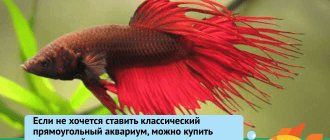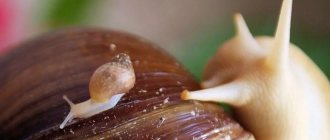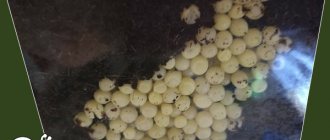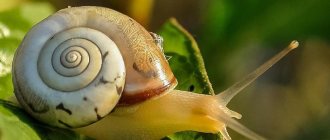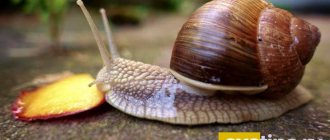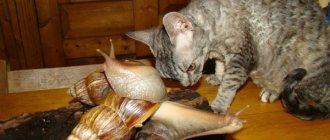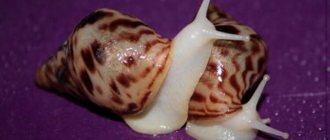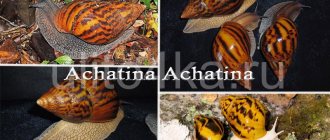Characteristics
The size of adult snails ranges from 50-100 mm, although there are individual specimens whose size is 20 cm or even more. The snail has a conical shell twisted counterclockwise.
In adult individuals, the shells differ in seven to nine turns, and their color largely depends on the habitat, including diet. Despite such factors, the main color of the shells is yellowish with reddish-brown stripes.
Types of land snails
In nature, there are about one hundred species of Achatina. The most common are:
- Achatina fulica with a variegated shell 20 cm long and a pattern of light longitudinal stripes. The soft body is brown and brown in color with noticeable bumps on the skin.
- The Achatina reticulata snail has a beautiful shell with a dotted or striped pattern and a soft body colored chocolate or black.
- Powelliphanta augusta is a rare gastropod species from New Zealand.
Other types of land snail:
- lemon Achatina (Iradel) with a yellow shell 6-8 cm long. Viviparous species.
- Achatina glutinosa (sticky) with a glossy shell surface. Its length is about 10 cm.
- Achatina reticulata has a shell with a rough surface and a pattern in the form of a fine mesh. The snail's head is brighter colored than the body.
- The Albopictus species is distinguished by the presence of a pink apex. The last whorl is darker than the remaining whorls. The first curls with uneven spots.
- The Kraveni land snail has a small shell of 5-7 cm; it does not tolerate high temperatures.
- Achatina immaculata reaches up to 15 cm in length. The color of the shell contains shades of brown and red with a wide stripe.
- a rare variety: the two-color immaculata has a two-color last whorl on the shell. Practically does not survive in captivity.
- Achatina panther with multi-colored stripes on the limestone cover.
- Zanzibarik land snail gives birth to live small specimens. Grows up to 10 cm. The body is light gray, the head is marked with a dark line. The shell is light yellow with a brown mesh pattern.
Mollusks living in natural conditions and bred in captivity differ in the color of their protective cover and body.
Purchasing an Achatina snail: a number of tips
Before buying such a pet, it would be a good idea to familiarize yourself with the care features and also ask what the snail feeds on. It is equally important to know what the features of its content are. Features include:
- It is better to buy a snail at a pet store, but before that it is better to observe how the snail behaves to determine its health. Here you can learn about her gastronomic preferences.
- It is equally important to study the terrarium and its equipment for volume, lighting, ventilation system, etc.
- African snails must be accompanied by special registration documents indicating their pedigree.
As a rule, private individuals who practice breeding land gastropods do not practice culling and try to sell the maximum number of snails. They can implement masonry and do not have all the necessary information regarding care and maintenance. Therefore, you should not expect complete information about the snails they sell. At the same time, they do not particularly care about their health.
It is important to know! The appearance of a mollusk can tell a lot, especially its shell, which must be uniform and free of cracks and other defects. The best option is to buy Achatina after it is at least 2 months old.
Breeders treat the snail breeding process with full responsibility and have all the information about these unique living creatures. Such people do not put profit at the forefront of their activities, therefore they always provide important information, both about the origin of the mollusks and their pedigree. They are constantly engaged in culling and do not practice the sale of clutches for breeding.
Advantages of keeping Achatina snails
Achatina can cause significant damage only in natural conditions. At home, Achatina is not only an interesting exotic pet, but can also benefit the owner. The advantages of keeping snails will help you make your choice.
- Do not harm humans or other domestic animals. They do not bite or scratch, that is, they are absolutely safe. The only thing that Achatina can harm if it gets out of the aquarium is to eat everything in its path. She is an omnivore; indoor plants, food left unattended, and even paper are suitable for her.
- Snails don't smell. This often plays a huge role when choosing a pet. Moreover, the number of snails contained in the aquarium does not matter. But it is still worth considering that this is a pet that also requires care. All excrement has a smell. There will be no smell only if you clean the aquarium in a timely manner.
- Quiet. Snails are silent pets. They don't make a single sound. All the time they either sleep, buried in the ground, or eat, or crawl along the ground and walls of the aquarium. Snails should be owned by those people who love absolute silence and tranquility.
- Do not cause allergies. Snails are often acquired by those who are allergic to cats, dogs, hamsters or chinchillas, but really want to have a pet. However, the reaction may be to snail protein, which is contained in the mucus. But the percentage of people who may be allergic to this protein is very small.
- They don't damage the furniture. There is one thing. If a snail gets out of the aquarium and gets to the walls, it will eat plaster and wallpaper. Under no circumstances should snails eat wallpaper. Paint, impregnation, glitter and many other things that are very harmful to the snails’ digestion often remain on the walls.
- They don't need attention. Achatina is often purchased by those who want a pet, but have little free time to pay attention and play with the pet. Snails are absolutely not demanding in this regard, unlike cats, dogs or parrots.
- Breeding. Many owners breed snails. This is a very profitable business, since a snail can lay from 50 to 500 eggs at a time. Even with about 80% hatching rate, this is a huge offspring.
- Relieves stress. Firstly, Achatina is interesting to watch. They slowly crawl around the aquarium and move their antennae and eyes in a funny way. Secondly, snail mucus contains potassium, which relieves stress if you make masks from mucus or massage with a snail.
- Benefits for the skin. Snail mucus contains mucin, which is widely used in cosmetology. Mucin has a rejuvenating effect and is used as a means to combat cellulite.
- Consumed as food. Snail meat is good for the digestive system, improves the functioning of internal organs, and has a beneficial effect on the nervous system.
Achatina snails are capable of storing sperm for about 2 years. Under comfortable conditions, she will lay eggs without a partner several times a year.
Terrarium construction, filling
Any transparent glass or plastic container can be used as a terrarium. At the same time, it should have a lid with ventilation holes. As many experienced shellfish owners point out, it is better to give preference to a horizontal type container. It should be taken into account that up to 10 liters of volume are needed to maintain one individual.
The terrarium should have a heating system, since Achatina loves warmth. Regardless of the season, the temperature in the terrarium should be at 26-28 degrees. For such purposes, it is better to use thermal mats that are safe to use. At the same time, it is important to control the temperature regime, since both a decrease in temperature and an increase in temperature are undesirable.
The lighting of the terrarium also plays an important role, although additional lighting at night is not necessary. It is necessary to protect the mollusks from direct sunlight, so you should never install the terrarium on a windowsill.
A layer of soil is placed at the bottom of the terrarium, in the form of a coconut substrate, which retains moisture well. The thickness of the layer depends on the size of the mollusks. Before the soil is used for its intended purpose, it is poured with boiling water, after which it must cool and dry. As an option, a top layer of pure peat, which has an acidity of 5-7 pH, is suitable.
Important nuance! A container with a large snail should be placed in places where there are no drafts or direct sunlight. In this case, it is very important that excess heat from various heating devices does not enter the container.
A number of additional elements should be placed in the terrarium, including high-quality drinkers and feeders made of soft and environmentally friendly materials. A big house and a pool wouldn't hurt. The most suitable option is to use food-grade plastic products. It is undesirable for mollusks to have either fairly hard or sharp objects in their homes, which can cause various injuries to the body. Some owners recommend planting crops in the form of lettuce or cat grass in their home. Additional accessories, such as twigs, stumps or wooden bark, will become an additional decoration for the interior of the terrarium.
Achatina snails - care and maintenance
Disadvantages of keeping Achatina snails
If you decide that it is still worth getting an Achatina snail, then in addition to the positive aspects, you also need to consider the negative aspects. You need to properly assess your capabilities before purchasing a snail. Moving is always stressful for any animal, which significantly reduces life expectancy.
- They cause disgust. Snails leave a slimy trail behind them, which makes many people feel disgusted. This mucus is constantly produced in the snail's body; it protects the sole from friction with the surface and facilitates the process of movement.
- You can't let him crawl around the apartment. Snails must be kept in an aquarium or container, and the container must be closed (holes must first be made in the lid). Otherwise, the snail will crawl out and may eat indoor plants, paper and even wallpaper. This will not only cause damage to the owner, but is also unsafe for the health of the snail. It may also get stuck somewhere and damage the sink.
- Worms and parasites. Often these parasites are harmless to the snail, but dangerous to humans.
- Passive. Achatina, unlike a cat or dog, will not greet you when the owner comes home, or play with excitement with a ball or candy wrapper. They slowly crawl around the aquarium, eat or burrow in the ground.
- Diseases. Like all animals, Achatina can get sick. It is worth considering that not all veterinarians are able to determine what ails a snail and prescribe treatment accordingly. Before getting a snail, you should first find a specialist.
- Diet. Snails feed on plant foods and require a varied menu. You can’t give Achatina the same foods all the time; they get used to them and refuse something new. They also eat a lot. And the more a snail eats, the more excrement it leaves behind. Accordingly, it is necessary to clean the aquarium more often.
- They multiply quickly. At one time, a snail can lay from 50 to 500 eggs. If the owner is not engaged in breeding, then such a huge offspring simply has nowhere to go. If you have purchased an adult snail or a pair of snails, you need to check the soil once a week to see if there are any masonry.
- Special soil. Ordinary soil or flower soil is not suitable for keeping snails. Use coconut substrate or sphagnum moss. The snail also often digs in the ground and crawls along the walls of the aquarium. Accordingly, it gets dirty in the soil and stains the walls of the aquarium.
- Care and maintenance. Requires high humidity and maintaining optimal temperature. At high temperatures, the snail can get burned; at low temperatures, it goes into hibernation. The walls of the aquarium must be irrigated every day to maintain humidity. Be sure to remove excrement once a day. If you rarely clean the aquarium, midges and bugs will appear, which are quite difficult to remove.
- Avoid falling from the walls. The aquarium should not have high walls. Snails crawl along the walls and often fall. The higher the walls, the more damage Achatina receives. When it falls, its shell cracks, which leads to illness and even death of the animal.
Interesting: “The benefits of Achatina snails.”
Snails are not particularly demanding in terms of care and maintenance. But still, it is a living creature and needs to be looked after. If the disadvantages of keeping it don’t frighten you, then it’s definitely worth getting an Achatina snail. Most often, people over 30 years of age are interested in purchasing it, since the skin benefits of snail mucus are invaluable.
Achatina diet
The basis of the diet of such mollusks can be lettuce leaves, various greens, shoots of cereal crops, as well as tops. In addition, the following food items should be included in their diet:
- Cucumber and pumpkin pulp.
- Spinach.
- Zucchini.
- Carrot.
- Ears of young corn.
- Peas.
- Tomatoes.
- Cabbage.
- Apple and pear pulp.
- Watermelons and melons.
- Bananas.
- Apricots.
- Avocado.
- Mango.
- Pineapples.
- Cherries.
- Plums.
- Raspberry.
- Strawberries.
Adults are often capricious, giving preference to certain specific foods and refusing others. Despite this, soft food items should be crushed and given in slices, while harder ones should be ground on a grater, as well as in a blender. All shellfish food should be at room temperature.
These pets should not be given food from the table that is included in the human diet. These are fried foods, spices, sweets, smoked foods, and sour foods. Various acids, including natural acids found in citrus fruits, are considered dangerous for shellfish. It is quite important that pets are provided with mineral supplements that contain a sufficient amount of calcium.
Important point! There should always be clean water in the terrarium. Mollusks not only drink it, but also perform water procedures. Therefore, the water needs to be changed daily.
Adult snails feed once a day, preferably in the evening. As for young animals, they must have food on a constant basis, as well as water. Food should be served on a kind of tray, which can be used as a leaf of lettuce or cabbage. If food remains, it is better to remove it from the terrarium.
Feeding
Having got an Achatina snail, you need to not only know how to care for it, but also what to feed the mollusk. Greens, lettuce, vegetables and tops – that’s what rabbis eat. In general, Fulica feeds more traditionally than, for example, Achatina reticulata, whose nutrition should be dominated by protein feeding.
Your pet's diet must include the following products:
- tomatoes;
- pumpkin and cucumber pulp;
- carrot;
- spinach;
- zucchini;
- avocado;
- cabbage;
- peas;
- corn.
However, this is not a complete list of what Achatina eats. Large and adult individuals are sometimes capricious in matters of feeding, and choose certain products from the offered lunch, ignoring others. Pets are especially sensitive to fruits. Many snail owners doubt whether they can give their pet sweet berries due to the high sugar content, and do so in vain. Giant African snails eat apples, bananas, strawberries, raspberries and other delicacies with great pleasure and benefit.
Achatina care
In fact, these living creatures do not require special care, but it is necessary to monitor the condition of their home. As soiling occurs, preventative cleaning is carried out, and general cleaning is carried out at least 2 times a month. At the same time, the inside walls of the terrarium and the lid are washed every day.
Cleaning the shellfish's home should be done using regular hot water and soft rags. It is acceptable to use a regular dishwashing sponge. It is not recommended to use chemicals for cleaning and washing dishes or the like.
It is important to know! Materials, devices and tools used for cleaning, cleaning and washing snails’ homes must be stored in a separate place.
Gastropods regularly take water treatments. In this regard, it is recommended to place a shallow pool in the terrarium. In addition, they need to arrange something like a warm shower. To do this, you need to take the snail in your hand and hold it over the sink. The stream of water directed at the snail should be warm and not strong. The snail is subjected to this procedure for 3 minutes, no more.
SNAIL CARE | Basics of content AKHATINA | ACHATINE SNAILS
What to feed Achatina?
If you want a pet like an African snail, care and nutrition are the main conditions for its healthy and long life. The mollusk eats plant foods: lettuce, cabbage, cucumbers, bananas, tomatoes, pumpkin, berries, sweet peppers, zucchini, melon, watermelon rinds. Egg whites or poultry meat in small quantities should be given only occasionally.
In summer you need to bring dandelion and clover leaves.
There should always be sepia, eggshells and chalk in the house; snails eat this mineral supplement, it is needed for the growth and strength of the shell.
There should always be a shallow container of clean water.
Bell pepper
Health, disease and prevention
A number of factors influence the health of a snail, such as:
- Maintenance problems associated with hypothermia or overheating of shellfish. Confinement in cramped housing, using either dry or too wet soil.
- Nutritional problems when shellfish are fed low-calorie foods that contain insufficient amounts of protein and calcium.
- Problems with living conditions associated with unsanitary conditions.
- Poor ventilation and poor quality soil.
- Neighborhood problems when the compatibility of different species is not taken into account.
If a pet refuses food completely or partially, becomes lethargic, becomes clogged in the shell, and various discharges in the form of thick mucus are observed, then this is the first sign that the snail is sick. The disease is also indicated by delamination of the shell. The most dangerous disease is when a gastropod falls out of its shell. Such consequences may be associated either with genetic predispositions or as a result of prolonged exposure to chemically harmful components, bacteria, infections or fungi.
As a rule, in this case the mollusk quickly dies. To protect yourself and your pet from negative processes, you should approach dietary choices wisely.
It is important to know! Thanks to the observance of preventive measures, such as constant monitoring of the cleanliness of the terrarium, adherence to nutritional rules, as well as proper care, it is possible to protect your pet from many diseases.
In case of careless handling of the snail, damage of varying severity may occur, compromising the integrity of the shell. Some damage to the shell can be removed with epoxy glue, but in any case the animal must be provided with food rich in calcium.
If you keep a snail in unsanitary conditions, it may develop parasites or infectious diseases, which require enormous effort to get rid of. To combat such phenomena, propolis-based ointments are used, as well as the drug “Mikoseptin” and iodine solution, which can be purchased at the pharmacy.
Popular types of Achatina
The most common species and the easiest to care for is the Achatina fulica species. The shell of these snails is distinguished by its variegated color, which changes its color depending on the diet. The snail's body may be brownish or brown in color with pronounced tubercles on the skin of the mollusk. Achatina fulica is slow and melancholy; she likes to relax a lot in a cozy corner of the terrarium.
Another common type of snail for home keeping is the reticulata. Its representatives are distinguished by a peculiar pattern on their shells in the form of dots or stripes. Body color is dark brown or black. Snails of this species are more sociable, they are mobile and curious, often raising their heads, wanting to examine what is happening.
Reproduction at home
Achatina mollusks represent the category of hermaphrodite animals, which is characterized by the presence of both male and female genital organs. The incubation period can last from one to 2 months, depending on the species, as well as the conditions of detention. These mollusks are quite prolific, so it is very important that the reproduction process does not get out of control. You just need to wash off the eggs that appear in a timely manner.
In order for the offspring to be healthy, during the incubation period it is necessary to very carefully clean the terrarium, paying special attention to temperature and humidity. After birth, the small snails are placed in a separate container.
It is better to fill the bottom of the container with lettuce leaves, which will serve as a kind of substrate. The smallest of the individuals will have to be fed with a liquid substance, with the addition of grated carrots, which promotes faster growth and strengthening of the shell. It is also necessary to remember that before the age of one and a half years it is necessary to take measures to prevent them from reproducing.
Reproduction of African Achatina snails. Snail pregnancy. Breeding Achatina at home.
Albino land snail
Albinism occurs in various groups of animals. Among land snails there are also individuals without pigment and a light yellow shell. Perhaps this is how the snail adapts to survival in a hot climate and protects itself from overheating. Albinos appeared in Russia from Austria as terrarium inhabitants. They live in an environment that is as close as possible to tropical conditions with high temperatures and high humidity. Albino morphs grow slowly, are smaller in size than colored snails, but attract attention with their unusual and original appearance.
A few words about health
With proper maintenance and feeding, Achatina does not get sick. Health problems occur in snails that live with irresponsible or lazy owners.
Signs that Achatina is sick:
- Indifference to food and water.
- He sits in the sink almost all the time.
- The sink is very flaky.
- A huge amount of mucus is released.
The main diseases of Achatina:
- Damage by parasites (worms, fungus, mites).
- Frostbite and burns.
- Illnesses due to exposure to chemicals (eg detergents, salt).
- Damage to the snail's body or shell.
